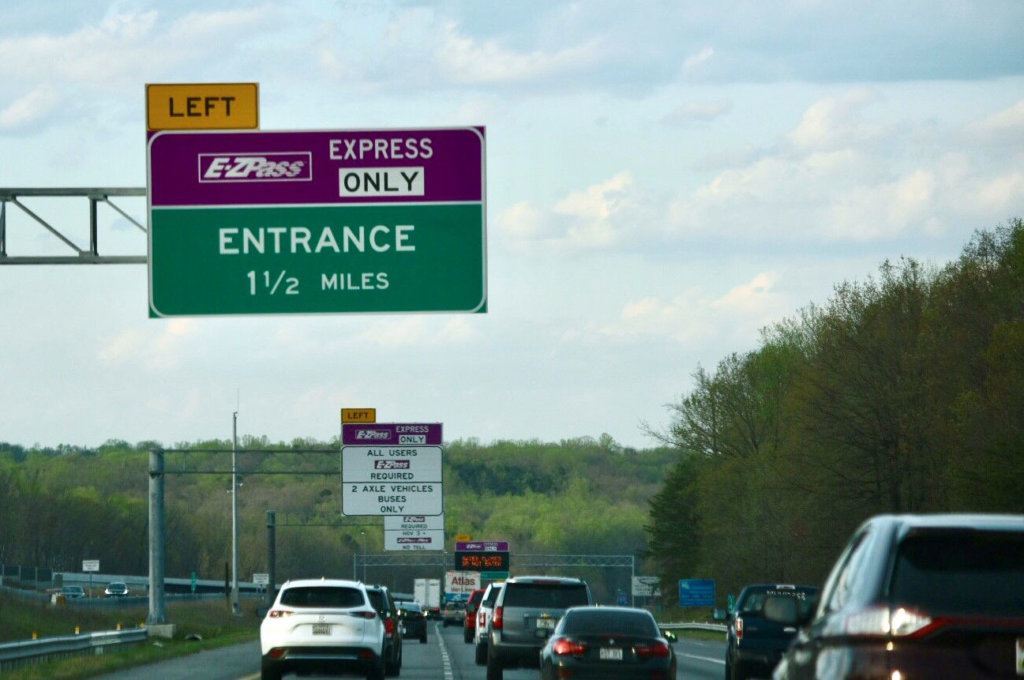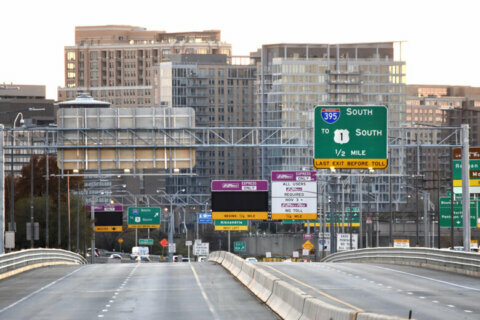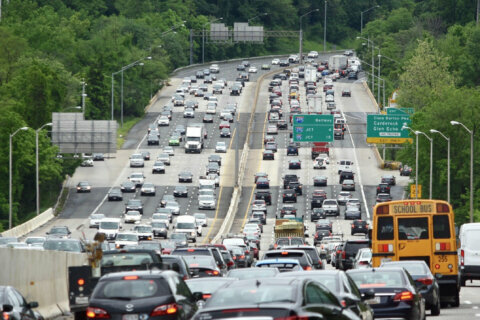
No traffic jams during the coronavirus pandemic stay-home orders means drivers are not seeing a reason to use Northern Virginia’s toll lanes.
Traffic in the 95 Express Lanes, 395 Express Lanes and 495 Express Lanes dropped significantly in the last two full weeks of March, according to an update to investors from Transurban, the company that runs the lanes.
Transurban warned investors Wednesday that its scheduled cash distributions could be reduced, with traffic on its toll roads around the world down significantly amid coronavirus quarantines, stay-home orders and other measures.
In its North America division, which includes both the D.C. area and Montreal, traffic was down 47% in the third week of March and 65% in the fourth week of March compared to a year earlier.
That led to a 23% overall decline in March, even after including the bump in Transurban’s recorded traffic from the launch of the 395 Express Lanes last fall. The 395 Express Lanes had helped boost traffic counts 15 to 20% in January and February.
Since the Express Lanes are parallel to the regular lanes on the Capital Beltway and Interstate 95, Transurban saw traffic decline more significantly there than on many of its other roads as drivers simply took advantage of quick trips in the regular lanes.
More specific traffic counts for January, February and March are scheduled to be released April 16. Drops are expected to be even more significant in April.
The separate I-66 rush-hour tolls for solo drivers inside the Beltway, operated by the Virginia Department of Transportation, also show significant traffic drops.
- Sign up for news alerts from WTOP
- Closings and delays
- Maryland stay-at-home order: What’s allowed
- Virginia stay-at-home order: What’s allowed
- What businesses can stay open in DC?
- What businesses can stay open in Maryland?
- What businesses can stay open in Virginia?
- Traffic and transit changes in D.C., Md. and Va. during coronavirus response
- Coronavirus test results in D.C., Maryland and Virginia
- Coronavirus FAQ: What you need to know
Though specific traffic counts are not available, the posted toll at 8:30 a.m. Wednesday to go all the way from the Beltway to the Potomac River was just $2. Before the coronavirus traffic dip, the price on that busiest day in the middle of the week typically peaked at or above $35 around 8:30 a.m.
The WTOP Traffic Center has noted major declines in traffic across the region since the second week of March.
There are no plans to suspend tolls or HOV requirements in the region. Even if there were, some longer-term changes could require federal approval.
Construction continues along I-95
Transurban is continuing construction work on the 95 Express Lanes extension south toward Fredericksburg, and continues regular preventive maintenance work.
The Fredericksburg Extension remains on track to open in late 2022.
“Works are currently continuing without disruption with site clearing, earthworks and bridge construction underway,” the investor presentation said.
Virginia and Maryland are continuing and even expanding road construction in some areas amid the traffic drop, with expanded lane closures to speed up work in areas from Route 7 to the Bay Bridge.
Other agencies, such as Metro, have expressed concerns about expanding work during this time of reduced travel, because it could bring more workers and contractors together to potentially spread the virus.
“We are exploring that, taking advantage of some of the closures we have and the reduced ridership, but … we’re not going to risk the health of our employees or our contractors,” Metro General Manager Paul Wiedefeld said Tuesday.
Metro has 19 stations closed indefinitely and has significantly cut rail and bus service. However, it plans to approve an interim budget Thursday that could expand certain rail service starting in July.
Metro has a summerlong shutdown planned at Orange and Silver Line stops in Virginia. Vienna and Dunn Loring are scheduled to be closed, trains will single-track at West Falls Church and trains will pass through East Falls Church on a single track without stopping.
Will traffic return?
It remains unclear when the region may start to get back to something closer to normal, with an indefinite stay-home order in Maryland. Virginia’s stay-at-home order is currently expected to run to June 10, and D.C.’s stay-at-home order at least into late April.
Transurban remains hopeful that traffic will return.
“Overall levels of traffic in major Chinese cities remain below normal, however traffic increases week-on-week since Feb. 10 are starting to exhibit recovery, as lockdown restrictions are lifted and industries recommence operations,” the company said.
“Highway traffic has rebounded faster than public transport, suggesting that social distancing is encouraging more people to commute using their cars,” Transurban noted.
The company said it has enough cash available to meet debt and capital obligations, but may put off nonessential spending.







